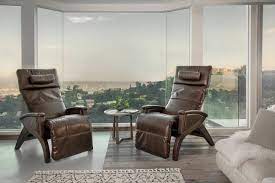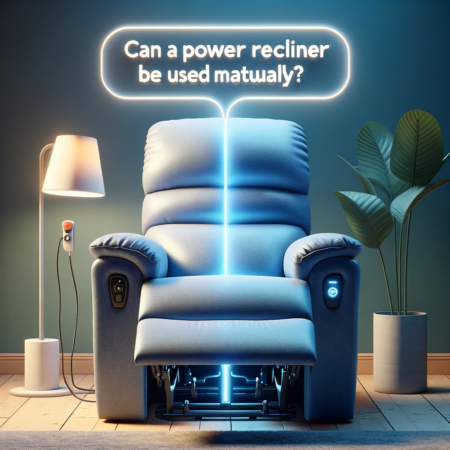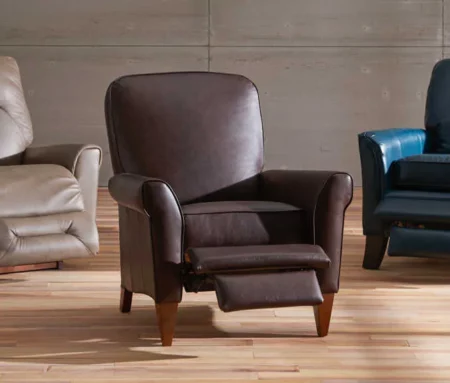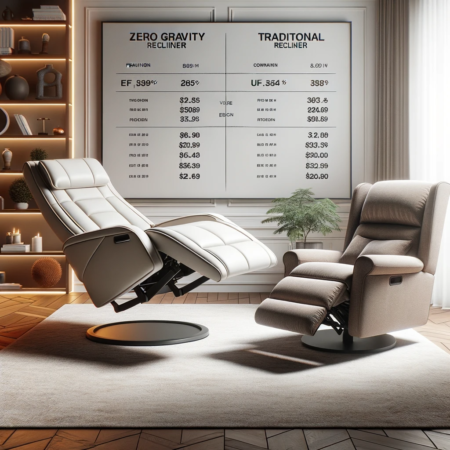Having a recliner in your living room can add a touch of luxury, offering unmatched comfort and relaxation. However, a common challenge many recliner owners face is preventing their furniture from sliding on wood floors.
Are you tired of constantly readjusting your recliner’s position or worrying about potential scratches on your beautiful wood flooring? Worry no more!
In this comprehensive guide, we’ll present five proven methods to keep your recliner firmly in place on wood floors, ensuring stability and granting you peace of mind.
5 Ways How To Keep Recliner From Sliding On Wood Floor?
Here we’re going to share 5 effective methods to keep your recliner from sliding on the wood floor. Personally, We’ve used the first three methods and found them to be very helpful.
1. Use Furniture Grippers
One of the simplest and most effective ways to prevent your recliner from sliding on a wood floor is by using furniture grippers.
These grippers are designed to provide traction and grip between your recliner and the floor, keeping it securely in place.
How to Apply Furniture Grippers?
To apply furniture grippers, follow the steps below:
- Choose the Right Furniture Grippers: Opt for grippers specifically designed for use on wood floors, as they are often made of materials that prevent scratches and offer superior grip.
- Clean the Recliner’s Feet and the Floor: Ensure the feet of your recliner and the floor are clean and free from any dust or debris. This will help the grippers adhere better.
- Attach the Grippers to the Recliner’s Feet: Peel off the adhesive backing of the grippers and firmly press them onto the bottom of each recliner foot. Make sure they are centered and properly aligned.
- Test the Stability: Gently try moving your recliner to test its stability. The grippers should provide enough traction to keep it from sliding.
Pros and Cons of Furniture Grippers
Pros
- Easy to apply and remove without causing damage to the floor
- Affordable and widely available
- Provide excellent grip on wood surfaces
Cons
- May leave residue on the floor when removed
- Need to be replaced periodically for optimal performance
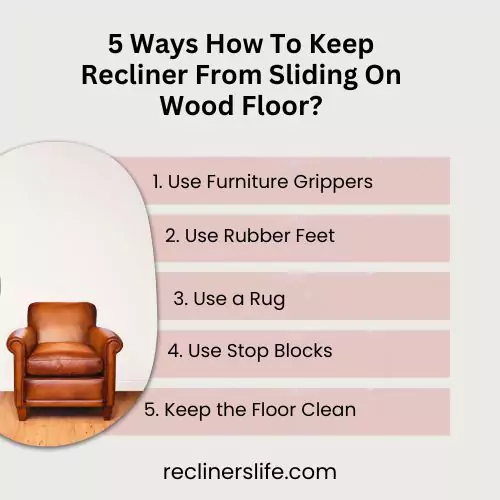
2. Use Rubber Feet
Rubber feet are another effective solution to prevent your recliner from sliding and protect your wood floor from scratches.
The rubber material provides traction, reducing the chances of accidental movement.
How to Install Rubber Feet?
Here’s how to install rubber feet:
- Choose the Right Rubber Feet: Look for rubber feet specifically designed for furniture use and suitable for wood floors.
- Remove Existing Feet (if applicable): Some recliners may come with removable feet. If this is the case, carefully detach them before installing the rubber feet.
- Clean the Recliner’s Feet: Ensure the feet are clean and free from any dirt or debris.
- Attach the Rubber Feet: Align the rubber feet with the bottom of each recliner foot and firmly press them into place. Make sure they are centered and securely attached.
- Check for Stability: Test the recliner’s stability by gently trying to move it. The rubber feet should provide a secure grip on the wood floor.
Pros and Cons of Rubber Feet
Pros
- Effective in preventing sliding and protecting the floor
- Durable and long-lasting
- Easy to install and remove
Cons
- Some rubber feet may leave temporary marks on the floor
- Limited design options compared to other methods
3. Use a Rug
Using a rug underneath your recliner can serve multiple purposes. It adds a decorative touch to your living space while also preventing the recliner from sliding.
How to Choose a Rug For Your Recliner
Here’s how to choose a rug and effectively use it:
- Select a Suitable Rug: Opt for a rug that compliments your room’s decor and is large enough to accommodate the recliner’s dimensions.
- Ensure Proper Placement: Place the rug in the desired location, ensuring it extends beyond the recliner’s footprint on all sides.
- Secure the Rug: Use rug grippers or double-sided tape to secure the edges of the rug to the floor, preventing it from moving along with the recliner.
Pros and Cons of Using a Rug
Pros
- Offers decorative enhancement to your living space
- Provides a non-slip surface for the recliner
- Offers versatility in terms of design options
Cons
- Requires regular cleaning and maintenance
- Rug edges may curl over time, requiring adjustments
4. Use Stop Blocks
Stop blocks are small wedges or blocks placed strategically under the recliner’s feet to prevent them from sliding.
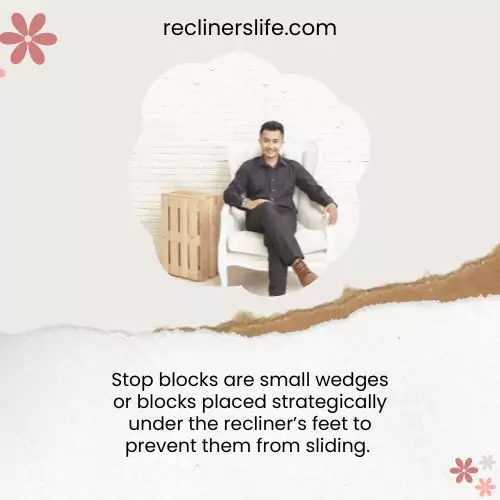
How to Choose Stop Blocks?
Here’s how to choose and use stop blocks effectively:
- Select the Right Stop Blocks: Look for stop blocks made of non-slip materials such as rubber or grippy silicone.
- Measure the Recliner’s Feet: Determine the size of the recliner’s feet and choose stop blocks that are slightly larger to provide a stable base.
- Place the Stop Blocks: Position the stop blocks under the front and rear feet of the recliner, ensuring they are flush against the floor.
- Test Stability: Apply gentle pressure to the recliner to ensure the stop blocks effectively prevent sliding.
Pros and Cons of Stop Blocks
Pros
- Provide a simple and inexpensive solution
- Easy to position and remove
- Can be used in combination with other methods for enhanced stability
Cons
- Visible underneath the recliner
- Require occasional readjustment if they shift over time
5. Keep the Floor Clean
Maintaining a clean wood floor is essential for preventing your recliner from sliding. Dust, debris, and even small particles can reduce the traction between the recliner’s feet and the floor.
How to Keep the Floor Clean?
Follow these steps to keep your wood floor clean:
- Sweep or Vacuum Regularly: Remove any loose dirt, dust, or debris from the floor using a broom or vacuum cleaner.
- Clean Spills and Stains Immediately: Wipe up any spills or stains promptly using a damp cloth or a suitable cleaning solution recommended for wood floors.
- Use Floor Cleaner: Periodically use a wood floor cleaner to maintain the floor’s cleanliness and enhance its grip.
Pros and Cons of Clean Floor
Pros
- Improves overall hygiene and aesthetics
- Enhances the grip between the recliner and the floor
- It helps maintain the longevity of your wood floor
Cons
- Regular cleaning and maintenance are required
- Some cleaning products may leave a residue if not properly rinsed
How to Know Which Method is Right for You?
Choosing the proper method to prevent your recliner from sliding depends on various factors such as personal preference, the type of recliner, and the specific characteristics of your wood floor.
Consider the following when selecting a method:
- The type of flooring you have (hardwood, laminate, etc.)
- The design and size of your recliner
- The level of stability you require
- Your budget and aesthetic preferences
Experimenting with different methods or using a combination of them can help you find the ideal solution for your recliner.
5 Useful Tips For Recliner Stability
- Regularly check the condition of your chosen method to ensure it remains effective.
- If using grippers or rubber feet, periodically clean them to maintain optimal grip.
- Place the recliner against a wall or other furniture to provide additional support.
- Avoid excessive force or sudden movements when adjusting the recliner to prevent instability.
- Consider professional installation or consultation if you have specific concerns about your recliner’s stability.
Conclusion
By implementing one or more of these effective methods, you can keep your recliner securely in place on your wood floor, ensuring stability and preventing unnecessary sliding.
Whether you choose furniture grippers, rubber feet, a rug, stop blocks, or a clean floor, each method offers its advantages and can be tailored to your specific needs.
Enjoy the ultimate comfort of your recliner without the hassle of constant readjustments or concerns about floor damage.
Frequently Asked Questions
Can I use furniture grippers on any type of floor?
Furniture grippers are designed to work on various floor types, including hardwood, laminate, and tile.
However, it’s essential to check the manufacturer’s recommendations to ensure they are suitable for your specific flooring.
Are rubber feet safe for my wood floor?
Rubber feet are specifically designed for furniture use and wood floors are generally safe and won’t cause damage.
However, it’s crucial to periodically check for any marks or residue and clean them promptly to maintain the floor’s appearance.
Will using a rug affect the recliner’s functionality?
Using a rug should not affect the recliner’s functionality, as long as the carpet rug is properly secured and does not interfere with the reclining mechanism. Ensure the carpet is large enough to accommodate the recliner’s movements.
Can I combine multiple methods for better stability?
Yes, you can combine different methods to enhance the stability of your recliner.
For example, using furniture grippers in combination with stop blocks or placing a rug under the recliner can provide additional grip and prevent sliding.
How often should I clean my wood floor to maintain recliner stability?
Regular cleaning of your wood floor is recommended to maintain recliner stability. Sweeping or vacuuming the floor regularly and promptly cleaning any spills or stains will help ensure optimal grip and prevent sliding.
